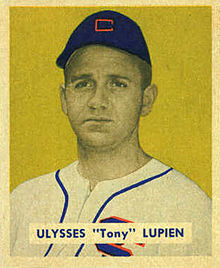Tony Lupien
| Tony Lupien | |
|---|---|
 | |
| First baseman | |
| Born: April 23, 1917 Chelmsford, Massachusetts | |
| Died: July 9, 2004 (aged 87) Norwich, Vermont | |
Batted: Left Threw: Left | |
| MLB debut | |
| September 12, 1940, for the Boston Red Sox | |
| Last MLB appearance | |
| October 3, 1948, for the Chicago White Sox | |
| MLB statistics | |
| Batting average | .268 |
| Home runs | 18 |
| Runs batted in | 230 |
| Stats at Baseball Reference | |
| Teams | |
| |
Ulysses John "Tony" Lupien (April 23, 1917 – July 9, 2004) was an American first baseman in Major League Baseball. He was a left-handed batter who played for the Boston Red Sox, Philadelphia Phillies and Chicago White Sox. Lupien was an all-around athlete and successful coach.
Early life
Lupien was born in Chelmsford, Massachusetts, the son of Eugenie (née Gosselin) and Ulysses J. Lupien.[1] His parents were of French Canadian descent, and he was named "Ulysses" because of his great-grandfather's admiration for president Ulysses S. Grant.[2] He graduated from Harvard University in 1939. At Harvard, he was captain of the baseball team as a junior and of the basketball team as a senior. He was the Eastern Intercollegiate League batting champion in 1938 and 1939, and he also was a quarterback for his freshman football team.[citation needed]
Career
Upon graduation from Harvard, Lupien signed a professional baseball contract with the Red Sox and played the 1939 season for the Double-A Scranton Red Sox Eastern League championship team. He made his major league debut for the Red Sox on September 12, 1940. One of his most productive seasons came in 1942 when he batted .281 with three home runs and 70 runs batted in for the Red Sox. He was traded to the Phillies where he played in 1944 and early in 1945, before serving in the U.S. Navy during World War II. In the 1944 season he hit .283 with five homers, 52 RBI, 82 runs, 23 doubles, 9 triples and 18 stolen bases. After his discharge from the Navy, Lupien played two years for the Hollywood Stars of the Pacific Coast League, where his 1947 record of batting .341, with 21 homers and 110 RBI, led to his return to the major leagues for one final season in 1948, with the White Sox.
Lupien finished his MLB career hitting .268 with 18 home runs, 230 RBI, 285 runs, 92 doubles, 30 triples, and 57 stolen bases in 614 games. In 1949, he played with Triple-A Toledo (American Association). He concluded his professional career from 1951–53 and in 1955 when he was a player as well as field and general manager with the Jamestown Falcons and Corning Independents, in the PONY League. From 1951 to 1956, he was head basketball coach at Middlebury College, compiling a record of 60–49 in five seasons.
In 1956, Lupien was hired as the Dartmouth Big Green baseball coach. He spent 21 seasons at Dartmouth College and guided his teams to 313 wins, 305 losses and three ties, winning the Eastern Baseball Intercollegiate League championship four times (1963, 1967, 1969–70). His 1970 team advanced to the College World Series at Omaha, Nebraska where it finished fifth. That team had a 24–10 record that included a 21-game win streak. He was also the Dartmouth freshman basketball coach from 1956 to 1968.
Personal life and legacy
Lupien retired from coaching in 1977, but continued to work for many years as a stockbroker with various firms in New England. He died in Norwich, Vermont, at 87 years of age. He was married to Natalie Nichols, and later to Mildred Robinson. His grandson is wrestler and actor John Cena.[3]
Lupien was recognized for decades as a great teacher and mentor. He was also an outspoken observer of labor relations in professional baseball. In 1980 he collaborated with writer Lee Lowenfish to author The Imperfect Diamond, a book that remains a definitive text on baseball labor from the introduction of the reserve clause in 1879 to the litigation in the 1970s that led to free agency.[4]
References
- ^ http://www.baseball-almanac.com/deaths/tony_lupien_obituary.shtml
- ^ Tony Lupien at the SABR Baseball Biography Project , by Charlie Bevis, Retrieved July 15, 2013.
- ^ "July 2013 Panorama Community Magazine by Panorama Community Magazine". ISSUU. Retrieved August 3, 2014.
- ^ http://www.baseball-almanac.com/deaths/tony_lupien_obituary.shtml
External links
- Career statistics from Baseball Reference, or Baseball Reference (Minors)
- Tony Lupien at Find a Grave
- 1917 births
- 2004 deaths
- People from Chelmsford, Massachusetts
- American basketball players
- Baseball players from Massachusetts
- Boston Red Sox players
- Chicago White Sox players
- Dartmouth Big Green baseball coaches
- Dartmouth Big Green men's basketball coaches
- Harvard Crimson baseball players
- Harvard Crimson men's basketball players
- Major League Baseball first basemen
- Philadelphia Phillies players
- Pacific Coast League MVP award winners
